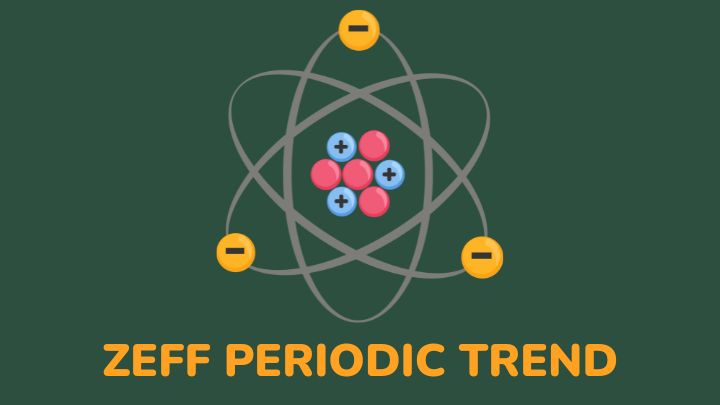Zeff, effective nuclear charge, is a periodic trend that measures the net positive charge experienced by an electron in the outermost shell. It determines the chemical behavior and reactivity of the element.
Zeff is sometimes mistaken for the nuclear charge of an element. But it is not. Although both properties measure attraction charges, they are different. Zeff considers the attraction between electrons and the nucleus, and nuclear charge measures only the charge in the nucleus.
There is a lot more about the effective nuclear charge that you should understand beyond this difference. Understanding the periodic trend of Zeff provides information on other periodic trends like ionization energy and electronegativity.
What is Zeff?
Electrons in an atom are arranged in shells, and each shell has an energy level. All electrons revolve around the nucleus but experience different levels of pull from it.
Electrons in higher energy levels will experience less pull from the nucleus, and those in lower energy levels will experience more pull.
The amount of nuclear charge on an electron in a multi-electron atom is the effective nuclear charge, Zeff, of that electron.
The Zeff of an element depends on the nuclear charge and electron shielding or screening effect or shielding constant. It can be determined by the formula, Zeff = Z – S. Z is the nuclear charge and S is the shielding effect or shielding constant.
Zeff also depends on the number of electron shells in the atom in consideration. The energy each of the outer electrons feels after the screening effect of the inner electrons is the effective nuclear charge.
What is the periodic trend for Zeff across the period?
Zeff increases as you move from left to right across the period. Across the period, the number of electrons increases, but the number of electron shells remains the same. There is a constant amount of shielding electrons but an increasing number of protons (because of the increasing atomic number).
Therefore, the distance remains the same, but the nuclear charge increases as the valence electrons are more drawn to the nucleus.
What is the periodic trend for Zeff down the group?
As you go down the group, Zeff decreases. Down the group, there are more electrons and more shells too. Since the number of shells increases, the shielding effect also increases.
The screening effect will naturally reduce the nuclear charge on the valence electrons, resulting in decreased effective nuclear charge.
In addition, as more electrons are added to new orbitals, atomic size will also increase, and the effective nuclear charge will decrease.
What is the relationship between the trend for Zeff and electron affinity?
Zeff and electron affinity are directly proportional to each other. The higher the Zeff, the greater the electron affinity. Electron affinity is the amount of energy released when an electron is added to a neutral atom to form an anion.
The more electrons that are added to the nucleus, the shorter the distance and the stronger the attraction between the electrons and the nucleus.
What is the relationship between Zeff and ionization energy?
The greater the effective nuclear charge, the higher the ionization energy. A higher Zeff implies that screening is constant, the number of electron shells remains constant, and nuclear charge increases.
A higher nuclear charge means that the electrons are tightly bound to the nucleus, and it will require more energy to remove one electron from the atom of an element.
This energy needed to remove the most loosely bound electron of an isolated atom, a molecule, or a positive ion is the ionization energy. A higher Zeff means a higher energy since all electrons will be tightly bound to the nucleus.
FAQs
Is there a difference between the Zeff and the shielding effect?
Zeff is the nuclear charge the nucleus has on an electron in an atom. The shielding effect or electron shielding is a reduction in the attraction force between electrons and the nucleus in an atom.
The shielding effect of an atom reduces the effective nuclear charge because it is reduced from the overall nuclear charge.
What is the difference between Zeff and nuclear charge?
Zeff is the positive charge the nucleus exerts on the outermost electron shell, while the nuclear charge is the electrostatic force that binds the electrons to the nucleus.
The effective nuclear charge is also the total charge on the nucleus and the inner electrons, while the nuclear charge is the total positive charge on the protons in the nucleus of an atom. In addition, Zeff is usually lower than the nuclear charge.
Does Zeff increase or decrease with atomic radius?
A higher Zeff means a smaller atomic radius. The higher the Zeff, the greater the attraction between the electron cloud and the nucleus. Therefore, the smaller the atomic radius.
Conclusion
Zeff, effective nuclear charge, increases across a period and decreases down the group. The higher the atomic number, the higher the Zeff. But, down the group, the number of shells and shielding electrons increase, resulting in decreasing Zeff.
Periodic trends have a relationship with each other. Zeff increases across the period with increasing ionization energies and electron affinity. But, down the group, Zeff decreases with increasing atomic radius.
Learn how to find the Zeff of an electron using Slater’s rule.
Thanks for reading.
